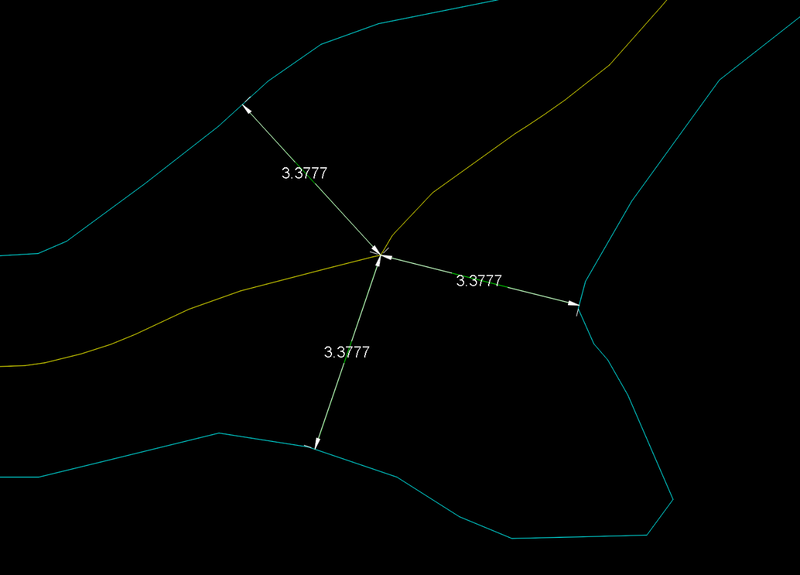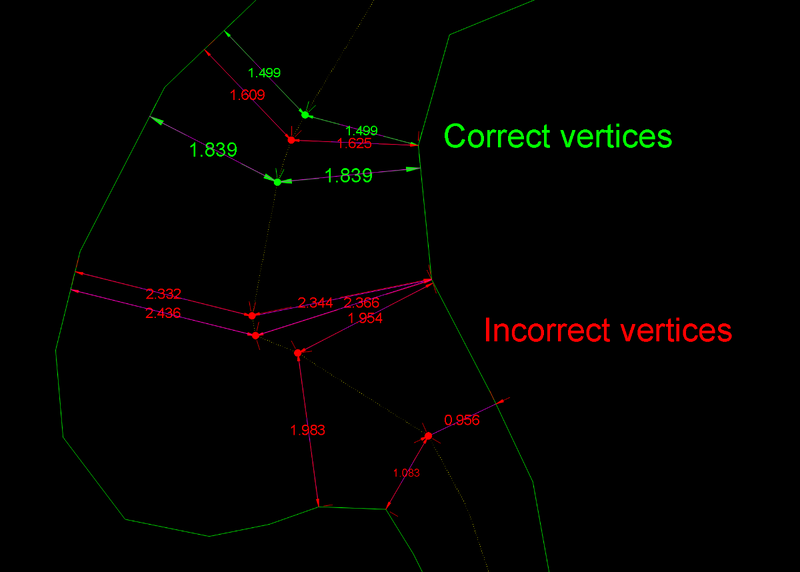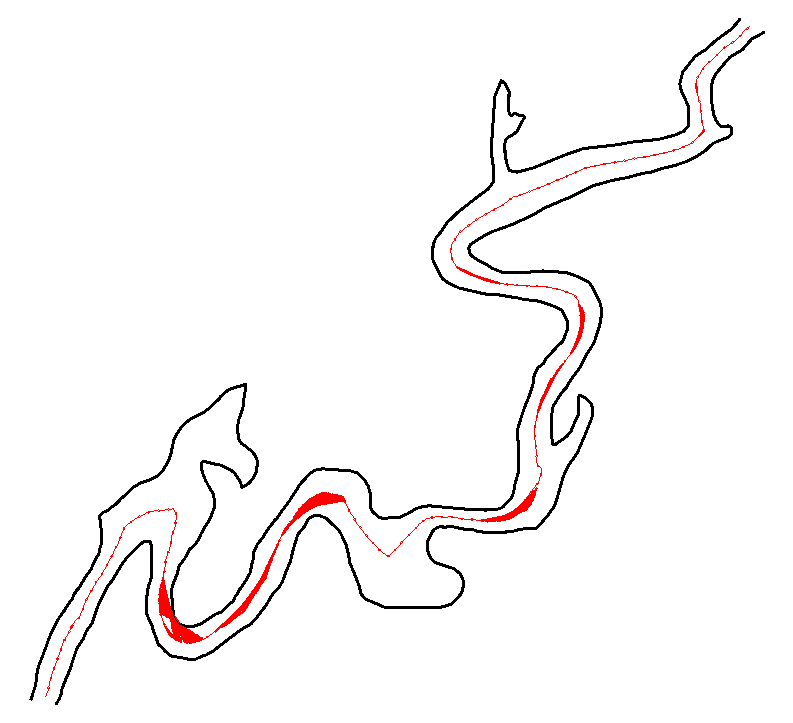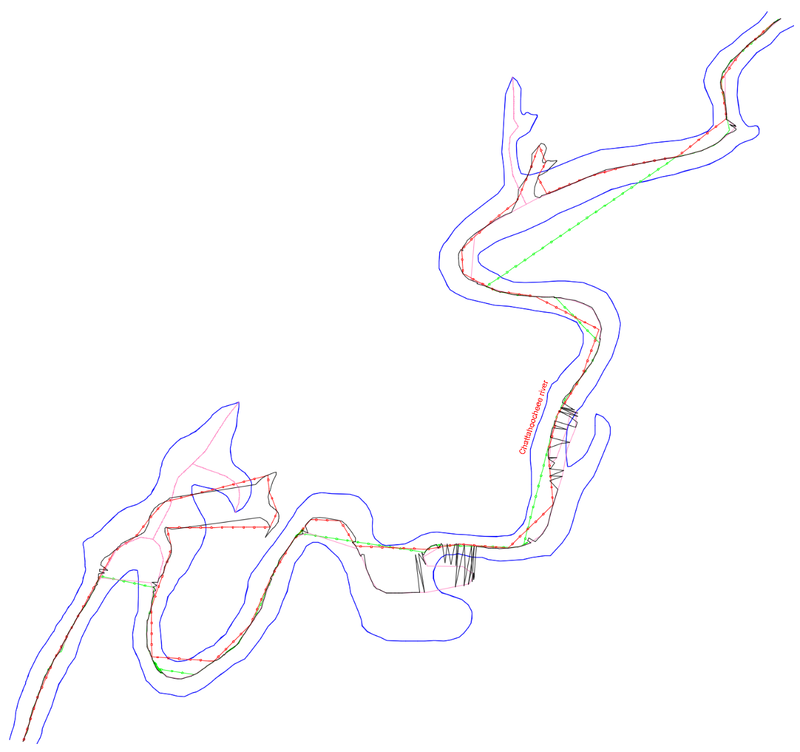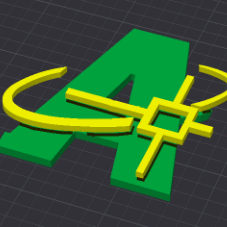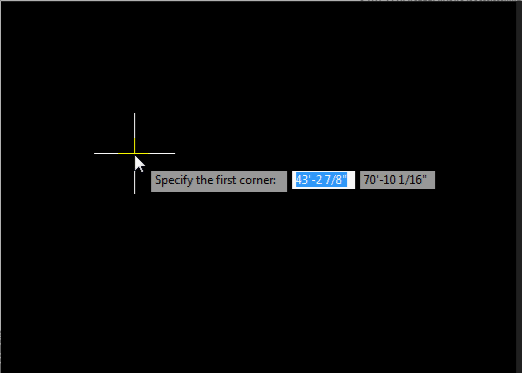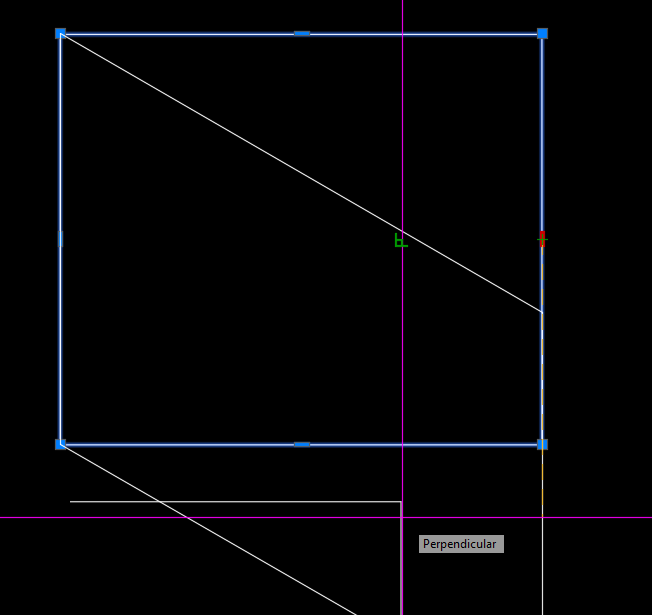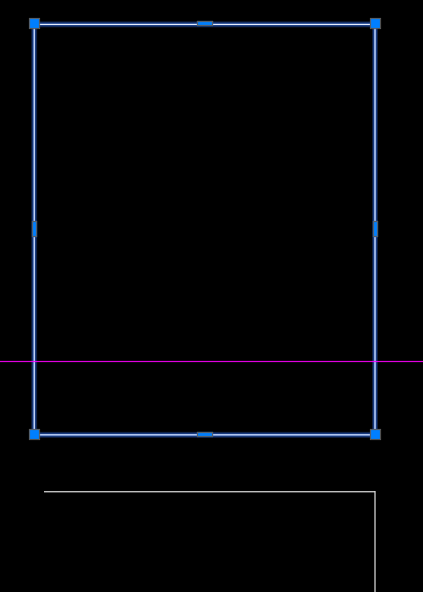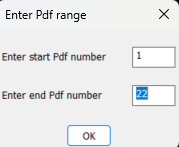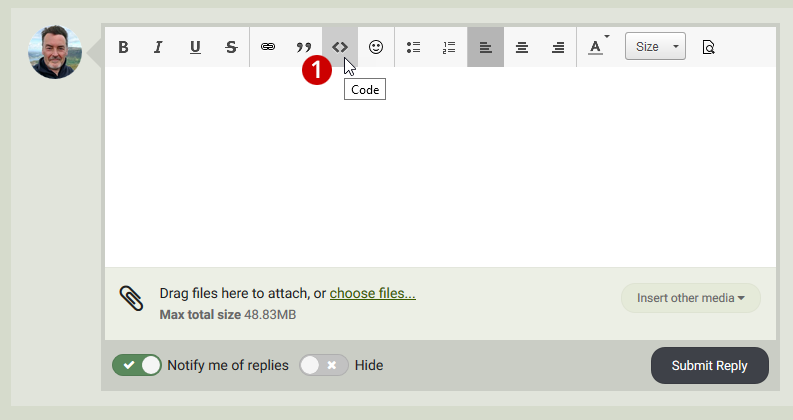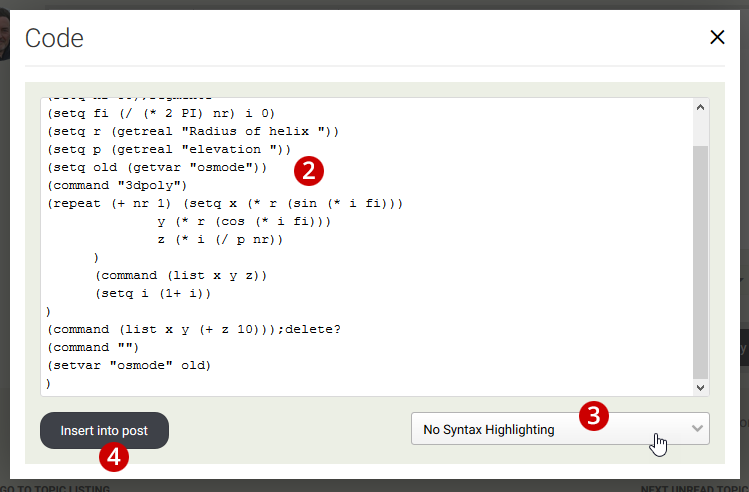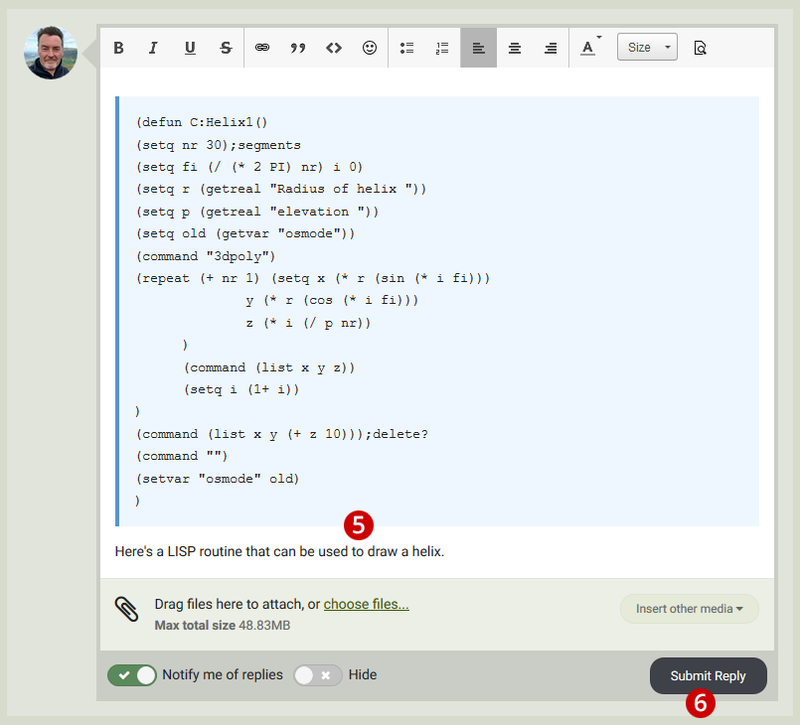Leaderboard
Popular Content
Showing content with the highest reputation since 12/07/2025 in Posts
-
Obviously, this has now become something more than just the search for a solution to a single user’s problem. First of all, I should say that I myself was also reluctant to accept the concept of equidistance advocated by @GP_ and @dexus For the simple reason that applying this principle forced me to accept that the centerline should be the same in these two drawings. Equidistance requires ignoring those areas of the margins that do not geometrically affect the axis. This, which initially caused me some resistance, I eventually came to accept conceptually when I realized that it could serve as a criterion for defining what is a “recodo/inlet” and what is not. So I have abandoned my previous approach and adapted it to this new situation. Having made this clarification, I must say that this concept of equidistance makes the calculation of a centerline more feasible. I’ve been running some tests with Dexus’s latest code, which is the best so far. However, I’ve discovered some “holes” that I hadn’t noticed before. I’m attaching a few images showing this. In my view, these are conceptual errors rather than geometric limitations. And what can we consider “geometric limitations”? I believe that, in any case, every vertex of the centerline must be equidistant from both margins. If this is not the case, the result is not correct. However, the intermediate regions along each segment may be subject to geometric limitations depending on the desired precision. Therefore, in bends or turns, the points taken within the adjustment or “problematic” segments may deviate (within a tolerance) from strict equidistance. The goal, therefore (in my opinion), should be to achieve equidistance at every vertex and to remain within a tolerance in the intermediate zone of each segment. After everything written here so far, some might wonder: is it really possible to obtain a centerline that meets these requirements? As far as I’m concerned, I’m running some tests. GusanoAcad.mp4 I’ll post something over the weekend3 points
-
This should achieve the desired result without overriding nested width formatting - (defun c:mtw ( / enx idx sel str wid ) (initget 6) (cond ( (not (setq wid (getreal "\nSpecify new width factor: ")))) ( (setq sel (ssget "_:L" '((0 . "MTEXT")))) (repeat (setq idx (sslength sel)) (setq idx (1- idx) enx (entget (ssname sel idx)) str (assoc 1 enx) ) (entmod (subst (cons 1 (addupdatewidth (cdr str) wid)) str enx)) ) ) ) (princ) ) (defun addupdatewidth ( str wid / ps1 ps2 ps3 ) (cond ( (= "" str) str) ( (and (setq ps1 (vl-string-search "{\\W" str)) (setq ps2 (vl-string-search ";" str ps1)) (setq ps3 (vl-string-search "}" str ps2)) ) (strcat (addupdatewidth (substr str 1 ps1) wid) (substr str (1+ ps1) 3) (rtos wid 2) (substr str (1+ ps2) (- ps3 ps2 -1)) (addupdatewidth (substr str (+ ps3 2)) wid) ) ) ( (strcat "{\\W" (rtos wid 2) ";" str "}")) ) ) (princ)3 points
-
2 points
-
Untested I remember Lee Mac saying it was important to release the html obj as it could cause a memory leak or something. ;;----------------------------------------------------------------------------;; ;; Copy Selected Xref Path to Clipboard with prompt. ;; https://www.cadtutor.net/forum/topic/98871-xref-path-copy-to-clipboard (defun c:XrefToClipBoard (/ SS Blk Path html) (vl-load-com) (if (setq SS (ssget "_+.:E:S" '((0 . "INSERT")))) (progn (setq blk (vla-get-effectivename (vlax-ename->vla-object (ssname SS 0)))) (setq blk (vla-item (vla-get-blocks (vla-get-activedocument (vlax-get-acad-object))) blk)) (if (= (vla-get-isxref blk) :vlax-true) (progn (setq Path (vla-get-Path blk)) (vlax-invoke (vlax-get (vlax-get (setq html (vlax-create-object "htmlfile")) 'ParentWindow) 'ClipBoardData) 'setData "Text" Path) (vlax-release-object html) (alert (strcat "\nPath Sent to Clipboard\n Xref Path: " Path)) ) (princ "\nSelected Block isn't an Xref.") ) ) (princ "\nNothing Selected") ) (princ) ) -edit updated code.2 points
-
Thank you all for the replies. Lee & Tsuky, Your code works perfectly for me. Steven P, thanks for explaining what was happening under the hood, made perfect sense. As always, I appreciate it greatly!!2 points
-
2 points
-
Hi @PGia, wow, you managed to find another example that fails. Good stress testing! The reason mine fails is because it ignores the offset lines that are split in two or more parts. But some of the parts are still be usable and should be used. I looked into fixing this and managed to add those lines, but this resulted in some other problems so I didn't update the code on the earlier post yet. The zigzag problem is coming back on your example. The result below. I really need to find a solution for that, but it looks like I might have to use a path finding algorithm which would slow down the code a lot. Sorting the points by distance on the offset line is not enough anymore.2 points
-
Yes ! Your first step is get a copy of lee-mac dynamic block properties.lsp. I like others have used his code with great success. You may need to get all property names first, so you can then get in turn that property value, eg "Distance1", the current visibility state is much easier to get. If you get stuck just post again. https://www.lee-mac.com/dynamicblockfunctions.html2 points
-
Just a follow up. I posted that long before I knew the importance of making sure that the Author of the code is noted as well as where I found the code. All credit goes to Gilles Chanteau. I have no idea where I found that code... It is probably somewhere here on cadtutor. I have since, started making sure that ifo is included as a header in the file, that way it doesn't look like I am trying to take claim for it and also, if/when something stops working I know where to go to address the issue. ~Greg original posting of code: https://www.theswamp.org/index.php?topic=29339.msg350137#msg3501372 points
-
I think the real-world situation may be more complex than what we’ve seen here so far. I took a look at the links that @SLW210 attached and decided to test the Lisp codes proposed up to this point. I looked through my drawings for something that could serve as an example for this problem, but it was like looking for a needle in a haystack. So, in the end, I decided to look for something in the real world that clearly corresponds to this issue — something like this: So I drew those margins and tested all the codes that have appeared in this thread so far. The result was… this! In the drawing, you can see the ones that managed to reach the end. However, the codes by BIGAL, GP_, GLAVCVS, and MarkoRibar couldn't even do that. Here’s the drawing AxisExple4.dwg2 points
-
@Clint Please give it a try (defun c:lay-nam-to-capital (/ (ACAD-OBJ ADOC LAY-COLL)) (VL-LOAD-COM) (SETQ ACAD-OBJ (VLAX-GET-ACAD-OBJECT)) (SETQ ADOC (VLA-GET-ACTIVEDOCUMENT ACAD-OBJ)) (SETQ LAY-COLL (VLA-GET-LAYERS ADOC)) (vlax-for lay lay-coll (vla-put-name lay (strcase (vla-get-name lay))) ) ;_ end of vlax-for ) ;_ end of defun2 points
-
Obviously we don't have your batch LISP - I guess your company paid for this and so you are not going to be popular sharing that for all online. LISPs can be added to scripts - both as a command and as code. There are others out there such as ScriptPro and Lee Macs Script Writer which will do this. BigAl will often post snippets of scripts here to batch process files - last one he did was in the last week or so ago. You could even set this up as a stand alone script to do just the one task (see BigAls last example....) The first step for all is to get a LISP working as you want and well on a single file and then to do it as a batch (first time running the batch with a new LISP, perhaps check carefully that it doesn't do anything unexpected on other files). Plenty of examples out there to change layer names from one to another - have a look to see if you see one you like to use, or if there isn't am sure we can put one together - and use what is above as a started if you want to have a go, I think all the code you need is in the examples, just need to think how to change them to your needs2 points
-
Hi Steven P and all the fine colleagues here, I have been distracted by producing content for a department-wide customization package based in BricsCAD. Steven P, Your comments are sound and will be pursued. My lack of focus on my programming learning shows - embarrassingly. Let's see what i can do about gaining LISP knowledge and its practical application! Thanks for everything. Clint1 point
-
Excellent and encourages me all the more to learn more than lean so much.. Found a solution as when using a text with a space in front, it's automatically ignored.. Just slip this in after the: v (vla-get-TextString o) v (vl-string-left-trim " " v) ;; https://www.cadtutor.net/forum/topic/26510-remove-the-space-from-a-text/page/4/#findComment-3245781 point
-
Hola. Contesto desde el móvil y sin probarlo, pero si no me equivoco bastaría con introducir el guión modificando esta parte del código así: (command "_exportlayout" (strcat (getvar "dwgprefix") (vl-filename-base (getvar "dwgname")) "-" presentacion ) ;(getvar "ctab") ".dwg") @ivaj Ya nos dices si te va.1 point
-
Good day everyone! I've discovered new (old?) the possibilities of a true rectangle. It is very convenient to work with him! The only drawback is that the rectangle is unstable. You can create it and work with it only in the current file. If you then close and open this file, the properties of the true rectangle are lost. Is it possible to make it stable so that its properties are preserved? https://autocadtips1.com/2011/11/20/autolisp-make-a-real-rectacgle/ AutoLISP: Make a Real Rectangle Posted on November 20, 2011 by AutoCAD Tips A long time ago, AutoCAD used to make Rectangles and polygons as their own entities. When you made a rectangle and then did a LIST <enter> on it, it would show as a rectangle. Nowadays, these objects are those objects in their geometry but are made of polyline entities. So modifying these objects is sometimes hard. that’s where this routine steps in to help. This routine lets you create a rectangle and even after you continue working elsewhere in your drawing, you can come back to that rectangle and modify that object and it acts like how rectangles used to act in AutoCAD. Here’s how: TREC <enter> to start “True RECtangle” Create a rectangle how you normally create one When needed, this routine will let you drag a single corner and the rest of the rectangle’s geometry will adjust accordingly to keep its geometry as a rectangle. TrueRect.lsp1 point
-
Not too hard to create, a real pain to maintain as it must be compiled every time Autodesk decides to break binary compatibility1 point
-
Hi mhupp, Thank you for the response. the result says: ; error: ActiveX Server returned the error: unknown name: IsXRef1 point
-
Your code modified (defun C:MTW ; = MText Width (/ ss wf n mt val_text start end) (if (and (setq ss (ssget "_:L" '((0 . "MTEXT")))) (setq wf (getreal "\nWidth Factor to apply: ")) ); and (repeat (setq n (sslength ss)); then (setq mt (ssname ss (setq n (1- n)))) (setq val_text (getpropertyvalue mt "Contents")) (cond ((vl-string-search "{" val_text) (cond ((vl-string-search "\\W" val_text) (setq start (vl-string-search "\\W" val_text) end (vl-string-search ";" val_text 1) ) (repeat (1+ (- end start)) (setq val_text (vl-string-subst "" (chr (vl-string-elt val_text start)) val_text start)) ) (setpropertyvalue mt "Contents" val_text) ) (T (setpropertyvalue mt "Contents" (strcat "{\\W" (rtos wf 2) ";" (vl-string-left-trim "{" val_text) ) ) ) ) ) (T (setpropertyvalue mt "Contents" (strcat "{\\W" (rtos wf 2) ";" (getpropertyvalue mt "Contents") "}") ); setpropertyvalue ) ) ); repeat ); if (princ) )1 point
-
The code is adding a width string to the text. These characters are hidden but will show up if you click on the text and look at it in the properties menu, or via the LISP line: (assoc 1 (entget(car(entsel)))) In the code it adds {\\W'wf'; to the string where wf is the width factor Something like {\\W0.8;Here is a text string} If you run the code again, it will add another width factor to the text string... but won't remove the first, so you get something like this: {\\W0.5;{\\W0.8;Here is a text string}} - noting that the new text width is applied and then the first one is applied.. result is you only see what was applied first. Need to remove this formatting to the text string before applying a new one. You might also have issues if other text formatting is used, such as underlined, italics, bold... For width you might be able to amend Lee Macs Unformat LISP to just unformat the width portion: https://lee-mac.com/unformatstring.html In these text strings replace with just 'W' ACcFfHLlOopQTW and here ACcFfHLlOoPpQSTW change to SW ... and then apply the new width formatting from your LISP .. though CAD is off so not tested - all part of the fun for you! ...if Lee Mac is passing through, feel free to correct me, though many years later I am just about understanding some of your codes.1 point
-
IIRC, those are tough to manage on GIS programs with Add-ons made with Python, .NET, etc. Remember, real rivers/roads/ROWs have curves and organic shapes, not just straight lines. I did see some information on how to tackle those, hopefully it can be worked out, but don't expect perfection. As I mentioned, from what my daughter said and what I've seen in various related forums, the GIS pros are using whatever program and add-ons they can to get the bulk of it and cleaning up and filling in manually. Most that are doing those shapes want the main channel center, if needed I would ignore the very wide sections and side pieces and get those as center lines running back to the main channel separately. As your example shows, it would take separate polylines, so it will need to account for those sections and then ran again on the offshoots. You still haven't answered all of the questions asked. What type of work are you doing? What you have posted looks to be Civil and/or GIS work. I'll try some more on this when I can, I have also looked at some different shortest path codes, the last example is way over my head in LISP, I'll concentrate on the previous examples then try to run just the main channel on the last example .dwg. I have a full slate at work again today, but I'll try to jump back on this when I get some things out of the way. Home time is limited, but I'll try to get back on this with QGIS solution, I may see if my daughter's coworkers want to take a shot at these.1 point
-
Based on the title of your thread, here's an existing program to match dynamic block properties: https://www.theswamp.org/index.php?topic=44444.msg496892#msg496892 Where mirroring text in blocks is concerned, here's some food for thought: https://www.theswamp.org/index.php?topic=46271.msg513250#msg5132501 point
-
Don't use CIV3D much anymore but there is the command IMPORTSTYLES if I have the command name correct can choose what is imported from another dwg.1 point
-
1 point
-
1 point
-
It can be done, but it requires creating a custom object using ObjectARX (C++).1 point
-
Ugh I think I watched your video too fast. I haven't had much time to do anything slowly lately I believe object reactors only survive the current drawing session. You must consider that the reactor was created relative to an object name, and object names change between drawing sessions.1 point
-
Yes, but as it for as Title name for the topic. The plot is different. So, you're code will certenatly accomplish the desired result.1 point
-
1 point
-
Inside the "initget" you use "Screening_50.ctb Fill_Patterns.ctb" with "_", and inside the "getkword" you use "Screening 50%.ctb/Fill Patterns.ctb", which is not equal as it in "initget". Everything must be equal. So, according from your's "initget", the "_" can't be in use, because it's in use for localization (for eg. "_RECTANG", "_LINE", etc.). From this link you can find this: Keyword Specifications The string argument is interpreted according to the following rules: 1. Each keyword is separated from the following keyword by one or more spaces. For example, "Width Height Depth" defines three keywords. 2. Each keyword can contain only letters, numbers, and hyphens (-). One of the possible solutions is to use this: (initget 1 "Monochrome.ctb acad.ctb Grayscale.ctb Screening50.ctb FillPatterns.ctb") (setq plotstyle (getkword "\nChoose plot style [Monochrome.ctb/acad.ctb/Grayscale.ctb/Screening50.ctb/FillPatterns.ctb] <Monochrome.ctb>:")) (cond ((equal plotstyle "Screening50.ctb") (setq plotstyle "Screening_50.ctb") ) ((equal plotstyle "FillPatterns.ctb") (setq plotstyle "Fill_Patterns.ctb") ) ) Best regards.1 point
-
Yes, this will substitued all layers into the UPPERCASE.1 point
-
If I getted correct, this can be accomplish, but you need to do a systematization in naming the layers. One of the approaches can be to make an .txt file in which you will store the systematizated layers (the proper order must be, for e.g. "Tropic,Train,Traffic" or "Tropic\n" "Train\n" "Traffic\n" etc. The \n means new line). Then, you will run the code from my post, get an list of layers inside the drawing, then select desired layers to matches with .txt file from which you want to get a proper names (for e.g. in .txt file you have the layer name "TrAffiC", after choosing the layer "Traffic" in the drawing with "TrAffiC", you can substitued with proper name).1 point
-
Python, makes Batch processing a bit easier sometimes import traceback from pyrx import Ap, Db def capcaseLayers(db: Db.Database): lt = Db.LayerTable(db.layerTableId()) for name, id in lt.toDict().items(): l = Db.LayerTableRecord(id, Db.OpenMode.kForWrite) l.setName(name.upper()) def processDb(fpath: str): sdb = Db.Database(False, True) sdb.readDwgFile(fpath) sdb.closeInput(True) capcaseLayers(sdb) sdb.saveAs(fpath) #add new command @Ap.Command() def caplayers(): try: for fpath in Ap.Application.listFilesInPath("E:\\temp", ".dwg"): processDb(fpath) except Exception as err: traceback.print_exception(err)1 point
-
The PIP is here ‘pip install cad-pyrx’ https://pypi.org/project/cad-pyrx/, the project is here https://github.com/CEXT-Dan/PyRx It’s an amalgamation of BRX and ActiveX APIs. There’s some stuff for BIM as well.1 point
-
If using a script and running it over multiple dwgs then yes can load a lisp and then run it. The lisp can be very extensive a few lines or even hundreds. Open dwg1 (load "updatelisp") (c:updatelisp) close Y Open dwg2 (load "updatelisp") (c:updatelisp) close Y Open dwg3 (load "updatelisp") (c:updatelisp) close Y1 point
-
maybe its just a matter of name vs effective block name issue , haven't tested that. But I like the routine and maybe gonna extend it a little with above suggestions if I run into a project that could benefit from this. Did find a program , I think it's called able2extact or something , that also has OCR built in but it will set you back around two hundred dollars , lifte time subscription.1 point
-
Like @rlx this is a hard coded plot pdf using preset values, our dwg's used layouts one title block. the code is hard coded for a A1 sheet plotted as a A3 size. We just walked through the layouts and plotted. So does not matter what current plot settings are as they are ignored. We had multiple devices PDF, A1, A3 Color, A3 B-W. So code for each. (setvar "textfill" 1) (setvar "fillmode" 1) (COMMAND "-PLOT" "Y" "" "Plot To PDF" "Iso full bleed A3 (420.00 x 297.00 MM)" "m" "LANDSCAPE" "N" "W" "-6,-6" "807,560" "1=2" "C" "y" "Acad.ctb" "Y" "n" "n" "n" pdfName "N" "y" )1 point
-
@SLW210 have a look at this by Lee-mac may be useful. I did have problems may be my Bricscad or pdf I am using. https://www.theswamp.org/index.php?PHPSESSID=a86a2d2e880b6079f1d3aee842f41d9d&topic=39001.msg441632#msg441632 This may also be useful once you know count. (if (not AH:getvalsm)(load "Multi Getvals.lsp")) (setq vals (AH:getvalsm (list "Enter Pdf range" "Enter start Pdf number" 6 4 "1" "Enter end Pdf number" 6 4 (RTOS COUNT 2 0)))) ("1" "22")1 point
-
Hi everyone, I’ve been working on a small production tool in AutoLISP/VLISP for AutoCAD / Civil 3D and thought it might be useful to share here for anyone doing a lot of section or profile sheets. ## What problem it solves On corridor / section jobs we often end up with several paper-space viewports that all need to: - Use the same scale and twist - Stay aligned to a centerline / path (alignment, guide polyline, etc.) - Be re-centered after design changes The usual manual workflow for us was: 1. Set up one “master” viewport with the correct scale, twist, layers, etc. 2. Copy that viewport across the layout for each station/section. 3. Manually PAN/ZOOM/DVIEW in each viewport to center the correct station along the path. 4. Repeat that pan/zoom step any time the design or alignment changed. It works, but it’s tedious and easy to make mistakes when you have a lot of sheets. ## What SectionSync LITE does SectionSync LITE is a compiled VLX that: - Lets you pick a polyline path (e.g. alignment, section chain, etc.) - Associates multiple paper-space viewports with positions along that path - Updates the view center of each viewport so it “follows” the path - Preserves the existing viewport scale and twist - Can be re-run after design changes so you don’t have to manually re-pan everything It was written mainly with Civil 3D section/profile sheets in mind, but it’s just working with standard AutoCAD viewports and a polyline. ## Technical notes - Written in AutoLISP/Visual LISP and compiled to VLX for distribution. - Uses vla/vlax functions to read and set viewport center, width/height, and twist. - Path positions are based on cumulative distance along the selected polyline. - No reactors or custom objects – it just runs on demand and updates existing VPs. ## Demo + download Short demo video: https://youtu.be/l1JRbz4_owQ Download / more details (there’s a built-in 5-run / 7-day trial so you can test it on a real project): https://autolispwizard.gumroad.com/l/civabs If anyone is interested in the implementation details (polyline parameterization, handling UCS and VP twist, etc.) I’m happy to discuss approaches or share pseudo-code for the core parts.1 point
-
First of all , welcome to Cadtutor AutoLisp Wizard! My kind of work is 99% electrical & instrument loop diagrams so I don't often have to work with viewports and when I do its just for simple cabinet views and some instrument layouts. But I do appreciate users who contribute and share their hard work with other users , so although I'm not gonna use it my self , thank you for your contribution.1 point
-
maybe just something simple as : (setvar "filedia" 0) (command ".-plot" "No" "" "" "" (strcat (getvar 'dwgprefix) (getvar 'ctab) ".pdf") "No" "Yes") (setvar "filedia" 1)1 point
-
Great! Thanx! It did gave me an error after the first page so I changed one of your subs a little. added this line : (and blkRef (vlax-method-applicable-p blkRef 'Name)) (defun set-block-contents-color (blkRef layer color / blkDef) (if (and blkRef (vlax-method-applicable-p blkRef 'Name)) (progn (setq blkDef (vla-item (vla-get-Blocks doc) (vla-get-Name blkRef))) (vlax-for ent blkDef (vl-catch-all-apply 'vla-put-layer (list ent layer)) (vl-catch-all-apply 'vla-put-color (list ent color)) ) ) ) )1 point
-
Thank you @marko_ribar much simpler. Added look in current Layout or Model. In Civ3D may find surfaces also that are not displayed. (ssget "_X" (list (cons 0 "~3DSOLID")(cons 410 (getvar 'ctab))))1 point
-
Could go with a third Middle option. (setq layname (ApplyCASE "LAYERNAME")) LaYeRnAmE .... (defun ApplyCaSe (s / i n ch out) (setq n (strlen s) i 1 out "") (while (<= i n) (setq ch (substr s i 1)) (setq out (strcat out (if (= (rem i 2) 0) (strcase ch T) (strcase ch) ) ) ) (setq i (1+ i)) ) out ) -Edit or a more realistic Option Only first letter UpperCase (setq layname (ApplyCASE "LAYERNAME")) Layername (defun ApplyCase (s / i n ch out) (setq n (strlen s) i 2 out (strcase (substr s 1 1) T)) (while (<= i n) (setq ch (substr s i 1)) (setq out (strcat out (strcase ch)))) (setq i (1+ i)) ) out )1 point
-
Code posting guidelines When you are posting AutoLISP or VBA code in these forums, there are some simple guidelines you should observe in order to make life easier for you and for others. Always add routines or code snippets using the Code option. This makes them easier to read within posts by making them distinct from other text. It helps those who may want to copy and paste the code. It also helps to save space because code blocks get a scroll bar beyond a certain number of lines. 1. Click the Code button on the editor toolbar. That's the one with the "<>" on it. You will then see the Code modal, shown below. 2. Type or paste your code into the text box. 3. Select "No Syntax Highlighting" from the drop-down. 4. Click Insert into post. 5. Add any instructions or additional commentary to your post. 6. Click Submit Reply (or Submit Topic if you are starting a new topic). See the next post in this topic for the final result. Please ensure that you have the right to publish code on a public forum. In most cases, the code you are publishing will be your own and it will be assumed that if no attribution is given, you are the author. However, if you are not the author, you must make this clear and where possible, give credit to the author. Any routines published here must have their header intact, including any title, instructions, author contact details, date and copyright information. If at all possible, please make sure that you have the author's permission to publish their work. You may, at your discretion, claim specific copyright over your code. All authors have the right to explicitly claim copyright of their code. We recommend that if you wish to do so, you use a standard form such as Creative Commons.1 point




